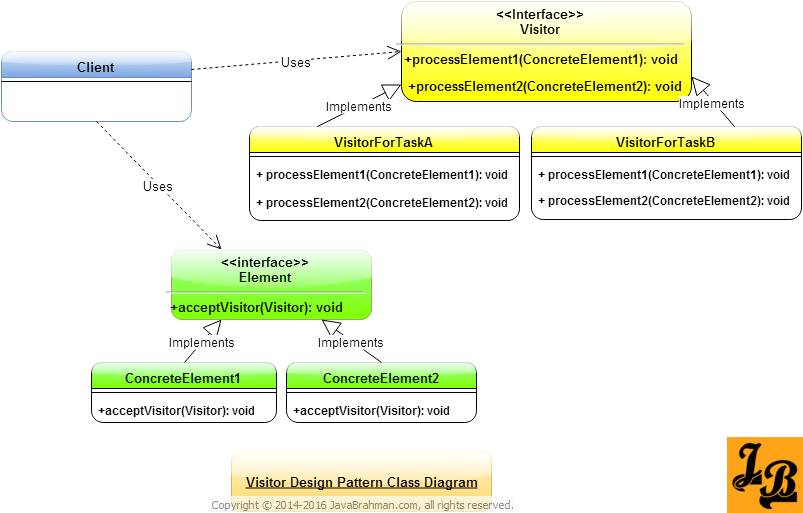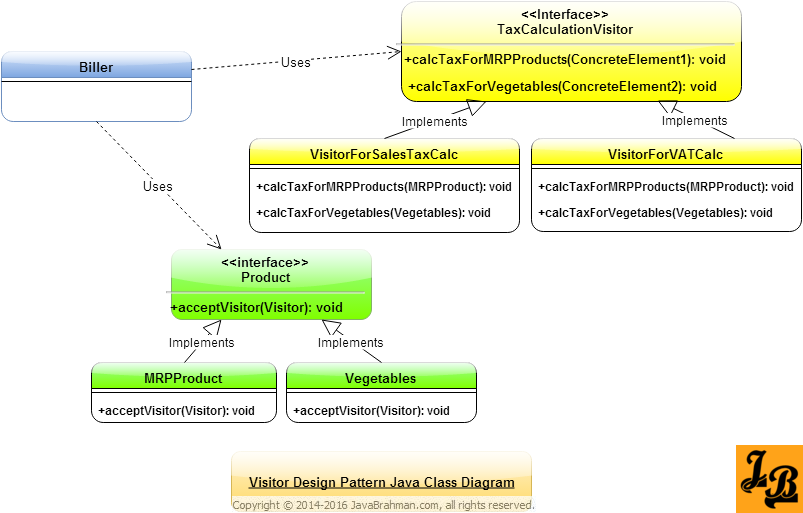Visitor Design Pattern in Java
This article explains Visitor design pattern in java with class diagrams and example code.
Introduction
Visitor Design Pattern is a behavioral design pattern among the Gang Of Four(GOF)Article on GOF Patterns & their types Design Patterns. Being a behavioral design pattern, the visitor pattern deals with how the classes interact with each other.
What is Visitor Design Pattern Visitor pattern defines operations in a way that they can be performed on the objects arranged in a structure independently of the object structure itself. Independently here implies that these operations are added & applied independently of the object structure on which they operate. Object Structure here refers to how the objects are related to one another such as nodes in a tree, graph etc.
Typical structure of classes in Visitor Design Pattern There are 2 independent class hierarchies in a typical visitor pattern implementation-
Lets look at the class diagram of a Visitor pattern to understand the hierarchies better -
Class Diagram for Visitor Design Pattern
 Explanation of Visitor Design Pattern Class Diagram
Explanation of Visitor Design Pattern Class Diagram
 Explanation of Visitor Design Pattern's Java Example's Class Diagram
The Java class diagram above depicts visitor pattern implemented for Tax Calculations in a Billing system where -
Summary
In the above tutorial we looked at what is visitor design pattern where we saw its class diagram for a facade design pattern & its explanation. We then saw the class diagram for an example of visitor design pattern in Java & its explanation. This concludes the tutorial on visitor design pattern.
Explanation of Visitor Design Pattern's Java Example's Class Diagram
The Java class diagram above depicts visitor pattern implemented for Tax Calculations in a Billing system where -
Summary
In the above tutorial we looked at what is visitor design pattern where we saw its class diagram for a facade design pattern & its explanation. We then saw the class diagram for an example of visitor design pattern in Java & its explanation. This concludes the tutorial on visitor design pattern.
What is Visitor Design Pattern Visitor pattern defines operations in a way that they can be performed on the objects arranged in a structure independently of the object structure itself. Independently here implies that these operations are added & applied independently of the object structure on which they operate. Object Structure here refers to how the objects are related to one another such as nodes in a tree, graph etc.
Typical structure of classes in Visitor Design Pattern There are 2 independent class hierarchies in a typical visitor pattern implementation-
- Element Hierarchy is for the elements which are to be worked upon.
- Visitor hierarchy is for the Visitors which operate on the Element Hierarchy. Where -
- Visitor & Element hierarchies are independent of each other in definition and compilation. This allows us to add classes in Visitor Hierarchy to apply operations on classes in the Element Hierarchy as they are traversed.
- Visitor hierarchy adds a new node for every new operation to be performed on the Element Hierarchy. This new Visitor node has a separate method for each of the nodes in the Element Hierarchy.
Class Diagram for Visitor Design Pattern

- There are two distinct hierarchies in the class diagram above.
Visitoris the base interface for Visitor Hierarchy. All theConcreteVisitorclasses implementingVisitorinterface together form the Visitor Hierarchy.Elementis the base interface for the Element Hierarchy. AllConcreteElementclasses implementingElementform the Element Hierarchy.- Each
ConcreteVisitorimplementation represents an operation to be performed on the classes in the Element Hierarchy. - Internally each
ConcreteVisitorhas a method corresponding to each of theConcreteElementinstances. These methods, named asprocessElement1(),processElement2()etc, contain the logic for applying the operation defined byConcreteVisitoron that specificConcreteElement. - Each
ConcreteElementimplements theacceptVisitor(Visitor)method inherited from theElementbase interface which allows them to get hold of the specificConcreteVisitorobject corresponding to the operation. - Thus, to add a new operation on the elements of
ElementHierarchythe following steps need to be followed -- Create a
ConcreteVisitorrepresenting the new operation. - In the new
ConcreteVisitorimplement methodsprocessElement1(),processElement2()etc as per the logic of the new operation. Clientneeds to create instance of aConcreteVisitoras per the operation it needs to perform on Element Hierarchy.- As the client traverses the Element Hierarchy it invokes
acceptVisitor()method on each of theConcreteElementinstances while passing to it theConcreteVisitorinstance. - The
ConcreteElementclass then in its code invokes its named method, i.e.processElement1(), on theConcreteVisitorit inherited.
- Create a

Billeris the client who calculates the total tax to be applied on the Products in a bill- There is a
Producthierarchy with aProductbase interface and has 2 types of Products -MRPProducts i.e. products sold at printed MRP andVegetables which are sold by weight without printed MRPs. - All individual products implement the
acceptVisitor()method where they invoke the appropriate method on the visitor named after them. For e.g.-MRPProduct'sacceptVisitor()method invokes thecalcTaxForMRPProducts()method on visitor object passed to it. - There is a
TaxCalculatorhierarchy with aTaxCalculationVisitorbase interface and two child classes ofTaxCalculationVisitor-VisitorForSalesTaxCalc&VisitorForVATCalcwhich contains the logic for applying SalesTax & VAT on the two types of Products defined in Product Hierarchy. TaxCalculationVisitor& its children visitors have 2 methods corresponding to each of the product types -calcTaxForMRPProducts()&calcTaxForVegetables().VisitorForSalesTaxCalchas its own logic of calculating the two types of taxes and so doesVisitorForVATCalc.- So, when calculating sales tax
Billeriterates over the products in the bill, passing them theVisitorForSalesTaxCalcobject via theacceptVisitor()method. In theacceptVisitor()method the product implementation invokes the method on the visitor named after it(as explained above). TheBilleriterates over all the products in the same way, calculates sales tax for all the products to get the total sales tax for the bill. - Similarly VAT is calculated by iterating and visiting all the products with object of corresponding
VisitorForVATCalcclass. This is how the visitor pattern works.
Gang of Four (GOF) Design Patterns on JavaBrahman
Creational Patterns: Factory method PatternFactory Method Design Pattern in Java Builder PatternBuilder Design Pattern in Java Prototype PatternPrototype Design Pattern in Java
Behavioral Patterns: Chain of Responsibility PatternChain of Responsibility Design Pattern in Java Observer PatternObserver Design Pattern in Java Iterator PatternIterator Design Pattern in Java State PatternState Design Pattern in Java Memento PatternMemento Design Pattern in Java Visitor PatternVisitor Design Pattern in Java Strategy PatternStrategy Design Pattern in Java Template Method PatternTemplate Method Design Pattern in Java
Structural Patterns: Adapter PatternAdapter design pattern in Java Composite PatternComposite Design Pattern in Java Facade PatternFacade Design Pattern in Java Proxy Pattern Java Proxy Design Pattern in Java
Analysis of Patterns: Strategy vs State PatternStrategy Design Pattern versus State Design Pattern
Creational Patterns: Factory method PatternFactory Method Design Pattern in Java Builder PatternBuilder Design Pattern in Java Prototype PatternPrototype Design Pattern in Java
Behavioral Patterns: Chain of Responsibility PatternChain of Responsibility Design Pattern in Java Observer PatternObserver Design Pattern in Java Iterator PatternIterator Design Pattern in Java State PatternState Design Pattern in Java Memento PatternMemento Design Pattern in Java Visitor PatternVisitor Design Pattern in Java Strategy PatternStrategy Design Pattern in Java Template Method PatternTemplate Method Design Pattern in Java
Structural Patterns: Adapter PatternAdapter design pattern in Java Composite PatternComposite Design Pattern in Java Facade PatternFacade Design Pattern in Java Proxy Pattern Java Proxy Design Pattern in Java
Analysis of Patterns: Strategy vs State PatternStrategy Design Pattern versus State Design Pattern